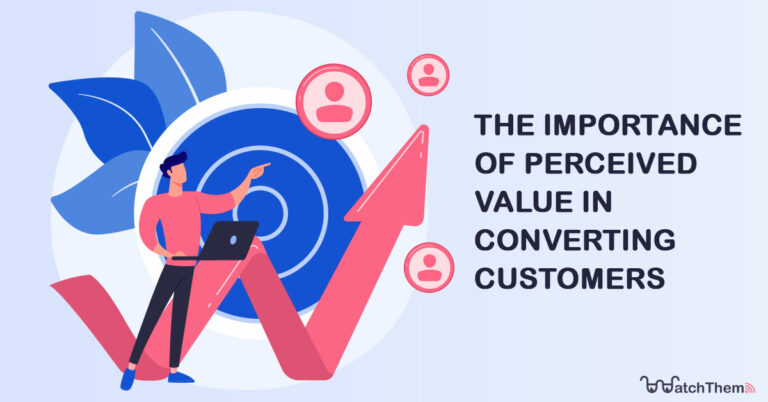Page Contents
Perceived value is an important concept, both in eCommerce and brick-and-mortar stores. It’s not an exaggeration to say customers purchase your products because of your product’s perceived value.
Understanding how perceived value works and improving it brings what almost any business wants: revenue! So, you should always consider products’ perceived value in your online shop’s CRO strategies.
This article will discuss this matter in converting customers with a focus on eCommerce. It all starts with understanding perceived value and realizing why customers buy something from you.
Perceived Value Definition
According to the Cambridge dictionary, perceived value is:
“The value of a product, based on how much customers want or need it, rather than on its real price.”
This definition may remind you of the saying, “beauty is in the eye of the beholder!” That’s exactly what perceived value is; it is in the eyes of your customers. All you should do is understand how they see your offer to improve their view.
Moreover, we can define a customer’s perceived value based on what they think it’s your product’s benefit and cost:
Perceived benefits are a product’s logical, physical, and emotional advantages for the prospective client. Perceived costs include monetary, time, and labor costs perception. However, there are other points to consider about customers’ perceived value:


Image Credits: tradeready.ca
1. Customer Perceived Value Is Different from the Product Price
Value can be misinterpreted, since many think it refers to the price of the product or service. For example, the low cost of non-brand clothing can have a high perceived value for a particular customer segment, while another customer segment may not think so. Instead, they may see “a unique shopping experience” or “product guarantee” as value. When they find an online shop that provides such experience and guarantee, they may be willing to pay more.
2. Customer Perceived Value Is Different from the Product Quality
You can offer a great product or service; however, your target market might not perceive or understand its value. On the other hand, your competitor may provide the same quality with a higher customer perceived value. You guess who wins the heart of the customer here.
The reason is that a customer’s perceived value is not necessarily the same as product quality or features. So, you should focus on what’s important for your customer and their needs to provide and promote that.
Why Do Customers Buy a Product/Service?
Customers buy an item when its perceived benefit is equal to or more than the price tag — when they feel they are getting good value for their money.
Customers do not buy items solely because of their features. In reality, product features are merely a way of delivering what a client truly desires: benefit.
For instance, customers do not buy a calculator to have one; they buy it to calculate numbers quickly and precisely. Likewise, people look for solutions in a Saas company, not software.
A buyer chooses a product based on the benefit it can provide. Therefore, customer perceived value is determined by this expected advantage, and product evaluation.
Is It Better to Decrease Price or Increase Perceived Value?
Mainly, marketing and advertising aim to increase the customer’s perceived value. That’s why we have a marketing budget to demonstrate to our customers how valuable our products and services are.
Marketing experts’ main goal is shaping and increasing the value of goods or services offered. The higher the perceived value, the more likely it is that people will spend money on you.
So, it’s better to work on the customer’s perceived value rather than provide discounts on your products and services.
Types of Perceived Value
Defining the product’s attributes regarding its utility or the extra benefits and values it provides can help marketers impact the product’s perceived value. The perceived utility of products can vary among similar products.
Companies try to create five types of utilities through their marketing campaigns.


1. Form Utility
Form utility considers the aesthetic appeal of the product’s physical design. Therefore, every product can increase its perceived value due to its attractive design.
2. Task Utility
Task utility considers the value of a service that saves the customer’s time, effort, or money.
3. Time Utility
Time utility considers the ease of access to a service/product. For example, 24-hour services, compared to 9-to-5-hour services, have different time utilities.
4. Place Utility
Place utility measures the convenience of the business’s location. Companies with more convenient locations have higher place utility.
5. Possession Utility
Possession utility measures the ease of the product purchase. Businesses with more options for their product purchasing have higher possession utility.
Special Considerations to Have in Mind About Perceived Value
The brand conveys different expectations related to its products. For example, a well-established brand can set a higher price than its generic equivalents. However, luxurious goods can carry more value because of their prestige, not their utility. While this is the case, smart bargains stand on the other side of the spectrum.
How Can You Increase Perceived Value to Convert More Customers?
Any marketing campaign’s ultimate purpose is to increase sales. Revenue powers the company and its activities. So, if you are not earning much, you should understand what gets in the way of your profitability.
Converting incoming traffic is as important as having enough traffic. When your conversion rate is low, you don’t earn money from incoming visitors. Hence, you need to find ways to increase it.
If your viewers are not converting, you can increase the perceived value to make them do so. In other words, the perceived value of your product is what motivates your clients to pay you.
Here are some ideas to help you increase conversion by increasing the perceived value:


1. Show How You Provide Value
Having a video about how your product/service helps your clients is better than describing your product. The benefits of your product will not be enough to convince your clients that your offer will address their issues. They’d want to know how it works and what kind of outcomes they may expect. They will communicate how your offer may aid them better through a demonstration.
2. Reduce the Entry Risk
Free trials work because they involve little to no commitment from your clients. Therefore, it eliminates the risk of not receiving what they expected.
3. Leverage Online Reviews
Reviews mitigate risk. They signal that your offer is interesting and that others are talking about it. It’s much better if your products or services’ reviews come from reputable sources and websites.
4. The Value of Customer Support
Remember that your consumers have the right to get a refund if they do not receive support from you. This is because they are paying you to provide them with ongoing value. However, this depends on the type of business you run.
These are just some ideas of how you can increase sales. Sometimes, having a low conversion rate is not about your customers’ perceived value. Having a tool with which you can watch your visitors’ actions on your website can help you a lot!


Tools such as WatchThemLive’s session recording are practical to find out UI and UX issues on your website. You can sign up for FREE and start optimizing your website.
Things to Consider When Trying to Increase Perceived Value
You can do things to increase your product’s perceived value. Here in this article, we will talk about things you need to consider while doing so.


1. Don’t Overpromise and Underdeliver
Increasing the value of your product by overpromising and underdelivering is not a good idea. Make sure you keep your promises about how your product will benefit the buyer.
Today, customers write and capture reviews and spread the good news about the product or service they bought from you. So when you improve the benefits of your product, everyone wins. This is because the consumer is pleased with the outcome and spreads the word about your brand.
2. The Value of Luxury
Although this may seem frightening, consumers are sometimes willing to spend extra money on products they view as luxurious.
3. Use FOMO to Your Advantage
People don’t want to have the Fear of Missing out (FOMO), and thus will buy limited items. Scarcity conveys a sense of urgency to shoppers. Even if you don’t sell a tangible product, launch a limited-time promotion and watch your sales skyrocket.
4. The Power of Social Proof
When customers see others interacting with your brand, they perceive it as more valuable than brands with lesser engagement. As a result, they are more willing to engage with your brand, liking and commenting on your social media.
Conclusion
Let’s wrap this up by saying that the most important thing in the sales and marketing process is perceived value. So, customers won’t purchase your products unless they find value in them.
We also discussed the differences between the concept of value, price, and quality. Keep in mind that every one of your company’s transactions is a value exchange. You must provide value to your clients before they pay you for it. It’s how eCommerce works these days.

